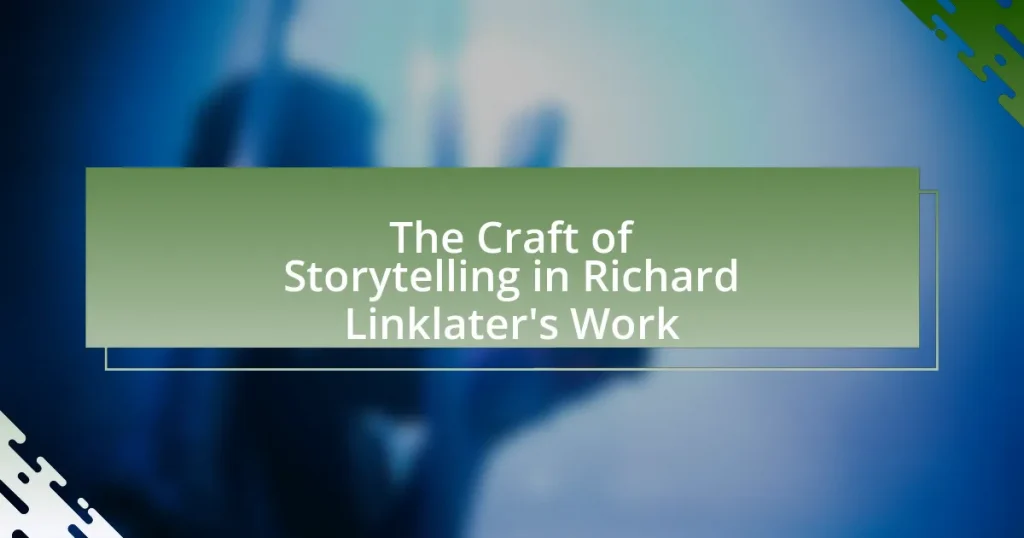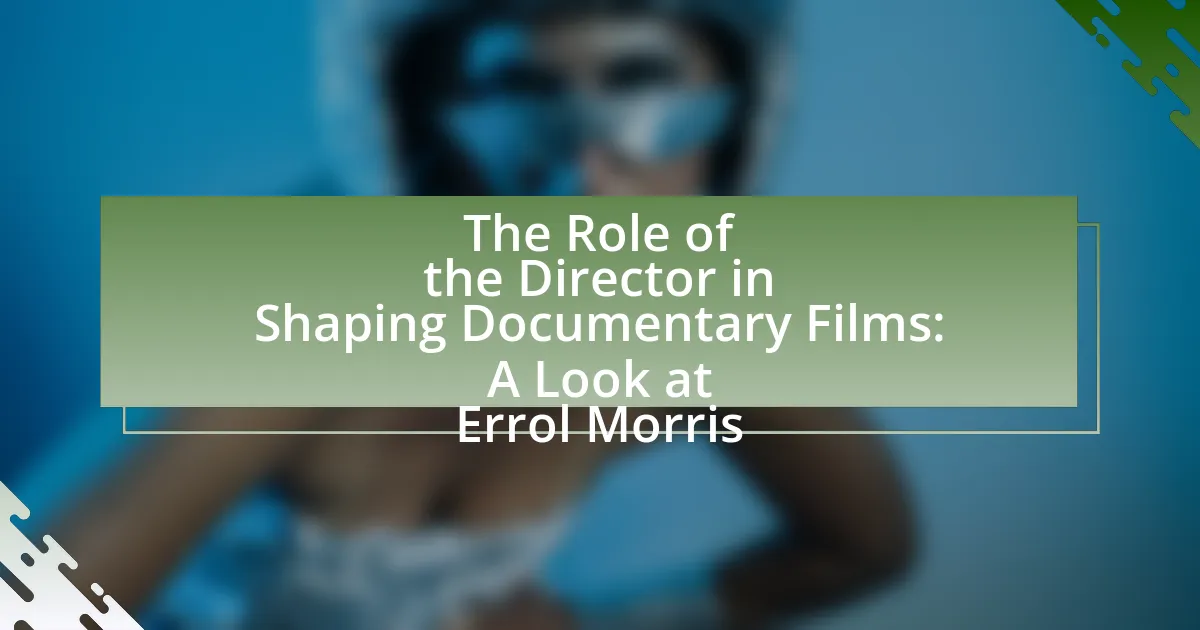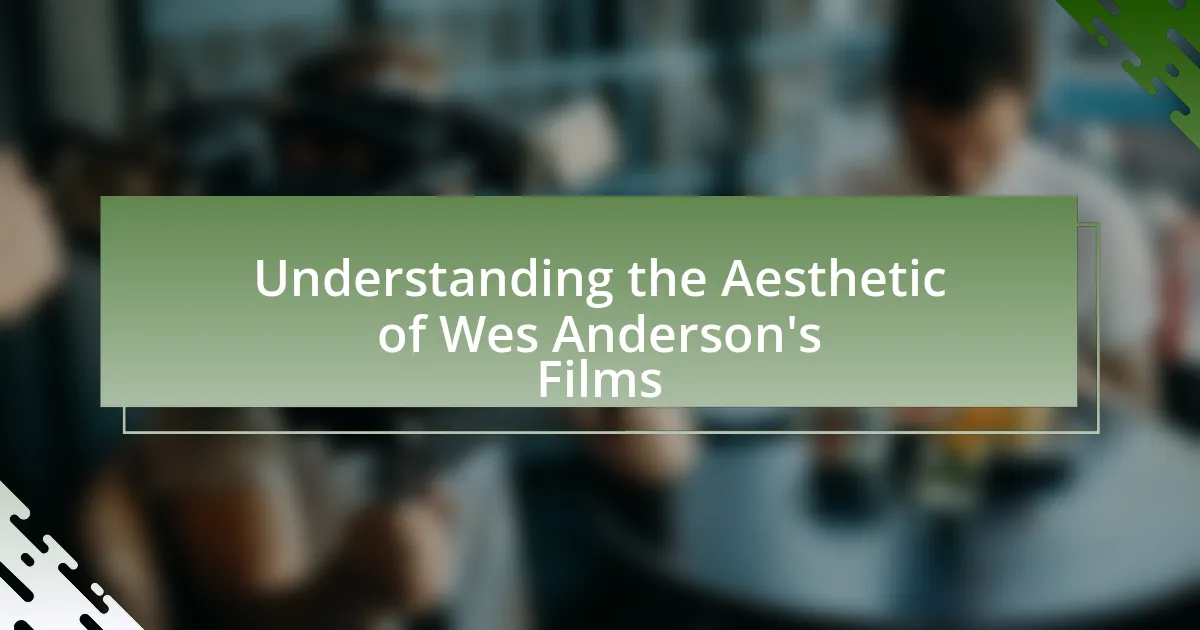The article examines the craft of storytelling in Richard Linklater’s work, highlighting his emphasis on naturalistic dialogue, real-time storytelling, and character development. It explores how Linklater’s approach differs from traditional narrative methods, focusing on the complexities of human relationships and the passage of time. Key films such as “Before Sunrise” and “Boyhood” are analyzed to illustrate his unique narrative techniques and the emotional depth they evoke. Additionally, the article discusses the philosophical influences on Linklater’s storytelling and the impact of his work on contemporary filmmakers, providing practical insights for aspiring filmmakers on developing relatable characters and effective dialogue-driven narratives.
What defines the craft of storytelling in Richard Linklater’s work?
The craft of storytelling in Richard Linklater’s work is defined by his emphasis on naturalistic dialogue and the exploration of time and human relationships. Linklater often employs real-time storytelling, as seen in films like “Boyhood,” which spans 12 years of a boy’s life, capturing the nuances of growth and change. His use of conversational exchanges, particularly in films such as “Before Sunrise,” “Before Sunset,” and “Before Midnight,” showcases authentic interactions that reflect genuine human experiences. This approach not only engages audiences but also invites them to reflect on their own lives, making his narratives resonate on a personal level.
How does Linklater’s approach to storytelling differ from traditional methods?
Richard Linklater’s approach to storytelling diverges from traditional methods by emphasizing real-time dialogue and character development over conventional plot structures. Unlike typical narratives that prioritize a linear progression of events, Linklater often focuses on the exploration of characters’ thoughts and relationships, as seen in films like “Before Sunrise” and “Boyhood.” This method allows for a more organic and immersive experience, reflecting the complexities of human interactions and the passage of time, which is a hallmark of his work.
What narrative techniques does Linklater frequently employ?
Richard Linklater frequently employs techniques such as real-time storytelling, non-linear narratives, and dialogue-driven scenes. Real-time storytelling is evident in films like “Before Sunrise,” where the narrative unfolds over a single night, allowing for deep character exploration. Non-linear narratives are showcased in “Boyhood,” which spans 12 years, capturing the protagonist’s growth through distinct life stages. Additionally, Linklater’s emphasis on dialogue, as seen in “Dazed and Confused,” creates authentic interactions that reflect the characters’ experiences and emotions, enhancing the overall storytelling.
How does Linklater’s use of dialogue enhance his storytelling?
Linklater’s use of dialogue enhances his storytelling by creating authentic, relatable characters and fostering deep emotional connections. His films often feature naturalistic conversations that reflect real-life interactions, allowing audiences to engage with the characters on a personal level. For instance, in “Before Sunrise,” the dialogue between Jesse and Céline unfolds in a way that captures the spontaneity and complexity of young love, making their relationship feel genuine and immersive. This technique not only drives the narrative forward but also invites viewers to reflect on their own experiences, thereby enriching the overall storytelling experience.
Why is character development crucial in Linklater’s films?
Character development is crucial in Linklater’s films because it drives the narrative and engages the audience on a personal level. Linklater’s storytelling often revolves around the exploration of time, relationships, and personal growth, as seen in films like “Before Sunrise” and “Boyhood.” In “Before Sunrise,” the evolving connection between the characters Jesse and Céline illustrates how dialogue and shared experiences shape their identities. Similarly, “Boyhood” uniquely captures the protagonist Mason’s growth over 12 years, emphasizing the significance of character evolution in understanding life’s complexities. This focus on character allows viewers to relate to the emotional journeys, making the films resonate deeply and reflect real-life experiences.
What methods does Linklater use to create relatable characters?
Richard Linklater creates relatable characters primarily through naturalistic dialogue and realistic character development. He often employs long, conversational scenes that reflect genuine human interactions, allowing audiences to connect with the characters’ thoughts and emotions. For instance, in films like “Before Sunrise,” the extended conversations between the protagonists reveal their vulnerabilities and aspirations, making them feel authentic and relatable. Additionally, Linklater’s use of real-time storytelling, as seen in “Boyhood,” captures the nuances of growing up, further enhancing the relatability of his characters by portraying their experiences over a significant period. This method of blending everyday life with profound themes resonates with viewers, making his characters memorable and accessible.
How do characters evolve throughout Linklater’s narratives?
Characters in Linklater’s narratives evolve through a process of introspection and real-time experiences that reflect their personal growth and changing relationships. For instance, in “Boyhood,” the protagonist Mason grows from childhood to adulthood, showcasing how life events shape his identity and perspectives over time. This evolution is marked by significant milestones, such as family dynamics, friendships, and romantic relationships, which are portrayed in a realistic manner, allowing audiences to witness the gradual transformation of characters. Linklater’s use of long-term storytelling techniques, such as filming over 12 years, provides a unique lens through which viewers can observe the authentic development of characters as they navigate the complexities of life.
What themes are prevalent in Linklater’s storytelling?
Richard Linklater’s storytelling prominently features themes of time, personal growth, and the exploration of human relationships. His films often delve into the passage of time, as seen in the “Before” trilogy, which captures the evolution of a romantic relationship over years. Additionally, Linklater emphasizes personal growth through characters’ journeys, notably in “Boyhood,” where the protagonist’s development is portrayed over 12 years. The exploration of human relationships is central to his narratives, highlighting the complexities of connections, as exemplified in “Dazed and Confused,” which examines teenage friendships and social dynamics. These themes are consistently woven throughout his body of work, reflecting a deep understanding of the human experience.
How does Linklater explore the passage of time in his films?
Richard Linklater explores the passage of time in his films through innovative narrative structures and character development that emphasize the fluidity of time. For instance, in “Boyhood,” he filmed the same actors over 12 years, capturing their real aging process, which creates a profound sense of time’s passage. Additionally, Linklater’s “Before” trilogy uses real-time dialogue and interactions over years to illustrate how relationships evolve, showcasing the impact of time on personal connections. These techniques highlight the natural progression of life and the significance of moments, reinforcing the theme of time as an integral element in human experience.
What role does nostalgia play in Linklater’s storytelling?
Nostalgia plays a central role in Richard Linklater’s storytelling by evoking a sense of longing for the past, which enhances emotional depth and relatability in his films. Linklater often explores themes of time, memory, and personal growth, as seen in works like “Boyhood,” where the passage of time is depicted through the protagonist’s life from childhood to adulthood, creating a nostalgic reflection on formative experiences. This approach resonates with audiences, as it taps into universal feelings of nostalgia, making his narratives more impactful and engaging.
How does Richard Linklater’s storytelling reflect his personal philosophy?
Richard Linklater’s storytelling reflects his personal philosophy through an emphasis on the passage of time, human connection, and the exploration of existential themes. His films, such as “Before Sunrise” and “Boyhood,” showcase a unique narrative style that prioritizes dialogue and character development over conventional plot structures, illustrating his belief in the importance of everyday experiences. Linklater often employs real-time storytelling and long takes, which serve to immerse viewers in the characters’ lives, reinforcing his view that life is a series of moments rather than a linear progression. This approach aligns with his philosophical interest in the fluidity of time and the significance of personal relationships, as seen in his recurring themes of nostalgia and the impact of choices on one’s identity.
What influences shape Linklater’s narrative style?
Richard Linklater’s narrative style is shaped by influences such as philosophical themes, real-time storytelling, and character-driven dialogue. His films often explore existential questions, reflecting the influence of philosophers like Jean-Paul Sartre and Friedrich Nietzsche, which is evident in works like “Waking Life.” Additionally, Linklater employs real-time storytelling techniques, as seen in “Boyhood,” where the narrative unfolds over 12 years, emphasizing the passage of time and personal growth. His focus on authentic, relatable dialogue draws from his experiences and observations of everyday life, making his characters feel genuine and grounded. These elements collectively define Linklater’s unique approach to storytelling.
How do Linklater’s life experiences inform his storytelling choices?
Richard Linklater’s life experiences significantly inform his storytelling choices by shaping his focus on themes of time, personal growth, and the human condition. Growing up in Texas, Linklater’s exposure to diverse cultural influences and his own experiences of adolescence and adulthood are reflected in his films, particularly in the exploration of relationships and the passage of time, as seen in works like “Boyhood” and “Before Sunrise.” His unique approach to storytelling, which often emphasizes dialogue and character development over traditional plot structures, stems from his belief in the importance of authentic human experiences, a perspective rooted in his own life journey.
What philosophical ideas are woven into his narratives?
Richard Linklater’s narratives are deeply infused with existentialism, emphasizing themes of time, identity, and the human experience. His films often explore the fluidity of time, as seen in “Boyhood,” which captures the passage of years in a single narrative, reflecting the existential notion that life is a continuous journey rather than a series of discrete events. Additionally, Linklater’s dialogues frequently delve into philosophical discussions, mirroring the Socratic method, where characters engage in conversations that question the nature of reality and personal beliefs, as exemplified in “Before Sunrise.” These elements illustrate Linklater’s commitment to portraying the complexities of human existence and the search for meaning within it.
How does Linklater’s storytelling connect with audiences?
Linklater’s storytelling connects with audiences through its emphasis on authentic dialogue and relatable characters. His films often explore themes of time, growth, and human relationships, which resonate deeply with viewers. For instance, in “Before Sunrise,” the naturalistic conversations between the protagonists create a sense of intimacy that allows audiences to reflect on their own experiences. Additionally, Linklater’s innovative narrative structures, such as the real-time unfolding of events in “Boyhood,” engage audiences by inviting them to witness the passage of time alongside the characters, fostering a unique emotional connection. This approach has been recognized for its ability to evoke nostalgia and introspection, making his work particularly impactful.
What emotional responses does Linklater aim to evoke through his films?
Richard Linklater aims to evoke a sense of nostalgia, introspection, and connection through his films. His storytelling often focuses on the passage of time and the complexities of human relationships, which resonate emotionally with audiences. For example, in “Boyhood,” the unique filming process over 12 years allows viewers to experience the protagonist’s growth and the bittersweet nature of childhood, fostering a deep emotional response tied to personal memories and life transitions. Additionally, Linklater’s dialogue-driven narratives, as seen in “Before Sunrise,” create intimate moments that encourage reflection on love and existential themes, further enhancing the emotional engagement of his films.
How does audience engagement play a role in Linklater’s storytelling?
Audience engagement is central to Richard Linklater’s storytelling, as it fosters a deep connection between the narrative and the viewer. Linklater employs techniques such as real-time dialogue and character-driven plots, which invite audiences to invest emotionally in the characters’ journeys. For instance, in films like “Before Sunrise,” the extended conversations between characters create a sense of intimacy that resonates with viewers, making them feel like active participants in the unfolding story. This approach not only enhances the relatability of the characters but also encourages audiences to reflect on their own experiences, thereby deepening their engagement with the film.
What are the key films that exemplify Linklater’s storytelling craft?
Key films that exemplify Richard Linklater’s storytelling craft include “Before Sunrise,” “Boyhood,” and “Dazed and Confused.” “Before Sunrise” showcases Linklater’s ability to create deep, meaningful dialogue and character development through real-time conversations between two characters over a single night. “Boyhood” is notable for its innovative narrative structure, filmed over 12 years, capturing the authentic growth and changes in a boy’s life, which emphasizes the passage of time and personal evolution. “Dazed and Confused” reflects Linklater’s skill in portraying the nuances of adolescence and the social dynamics of high school life, using a rich ensemble cast and a slice-of-life approach. These films collectively highlight Linklater’s unique approach to storytelling, focusing on character-driven narratives and the exploration of time and relationships.
How do specific films showcase Linklater’s unique narrative techniques?
Richard Linklater’s unique narrative techniques are prominently showcased in films such as “Before Sunrise,” “Boyhood,” and “Waking Life.” In “Before Sunrise,” Linklater employs real-time dialogue and character development, allowing viewers to experience the evolving relationship between Jesse and Céline over a single night, emphasizing the authenticity of human connection. “Boyhood” illustrates Linklater’s innovative approach to storytelling by filming the same actors over 12 years, capturing the passage of time and the natural growth of characters, which provides a profound sense of realism and relatability. In “Waking Life,” Linklater utilizes a rotoscoping animation technique that blends philosophical dialogue with dream-like visuals, creating a unique narrative structure that explores existential themes. These films collectively highlight Linklater’s focus on time, dialogue, and character-driven storytelling, reinforcing his distinctive voice in cinema.
What storytelling elements are highlighted in “Before Sunrise”?
“Before Sunrise” highlights several key storytelling elements, including dialogue-driven narrative, character development, and the exploration of themes such as love and connection. The film primarily relies on naturalistic dialogue to convey the evolving relationship between Jesse and Céline, allowing viewers to engage deeply with their thoughts and emotions. Character development is evident as both protagonists reveal their vulnerabilities and aspirations throughout their conversations, creating a relatable and authentic experience. Additionally, the film explores the fleeting nature of time and the significance of human connection, emphasizing how a single night can profoundly impact one’s life. These elements collectively contribute to the film’s unique storytelling approach, showcasing Richard Linklater’s mastery in crafting intimate and thought-provoking narratives.
How does “Boyhood” exemplify Linklater’s approach to time and character development?
“Boyhood” exemplifies Richard Linklater’s approach to time and character development through its unique 12-year filming process, which captures the real aging of its characters. This method allows for an authentic portrayal of growth and change, as viewers witness the protagonist, Mason, evolve from childhood to young adulthood in a seamless narrative. Linklater’s emphasis on naturalistic dialogue and everyday experiences further enhances character depth, illustrating how time influences relationships and personal identity. The film’s structure, which mirrors the passage of time in real life, reinforces the idea that character development is a gradual and organic process, making it a significant representation of Linklater’s storytelling philosophy.
What critical reception has Linklater’s storytelling received?
Richard Linklater’s storytelling has received widespread acclaim for its innovative narrative techniques and character-driven plots. Critics often highlight his ability to explore complex themes such as time, identity, and human connection, as seen in films like “Boyhood,” which was praised for its unique 12-year production process that captures the passage of time authentically. Additionally, Linklater’s “Before” trilogy has been lauded for its realistic dialogue and deep emotional resonance, earning him a reputation as a master of conversational storytelling. His work has garnered numerous awards, including Academy Award nominations, further validating the positive critical reception of his storytelling approach.
How have critics analyzed Linklater’s narrative style over the years?
Critics have analyzed Richard Linklater’s narrative style as innovative and reflective, often highlighting his use of real-time dialogue and character-driven storytelling. Over the years, they have noted that Linklater’s films, such as “Before Sunrise” and “Boyhood,” emphasize the passage of time and the evolution of relationships, which creates a sense of authenticity. Additionally, critics have pointed out his unique approach to non-linear storytelling and philosophical themes, as seen in “Waking Life,” where he explores existential questions through animated conversations. This analysis is supported by numerous reviews and scholarly articles that recognize Linklater’s ability to blend everyday experiences with deeper philosophical inquiries, establishing him as a distinctive voice in contemporary cinema.
What impact has Linklater’s work had on contemporary filmmakers?
Richard Linklater’s work has significantly influenced contemporary filmmakers by popularizing innovative narrative techniques and emphasizing character-driven storytelling. His films, such as “Before Sunrise” and “Boyhood,” showcase real-time dialogue and long-term character development, encouraging filmmakers to explore authenticity and the passage of time in their narratives. This approach has inspired a generation of directors, including Greta Gerwig and Richard Curtis, who incorporate similar themes of realism and emotional depth in their own projects. Linklater’s unique style has also contributed to the rise of independent cinema, demonstrating that personal stories can resonate widely, thus shaping the landscape of modern filmmaking.
What practical tips can aspiring filmmakers learn from Linklater’s storytelling methods?
Aspiring filmmakers can learn the importance of authenticity and character development from Richard Linklater’s storytelling methods. Linklater emphasizes natural dialogue and real-life experiences, which allows characters to resonate with audiences. For instance, in “Before Sunrise,” the organic conversations between characters create a relatable and immersive narrative. Additionally, Linklater’s use of time, as seen in “Boyhood,” showcases the significance of capturing life’s progression, encouraging filmmakers to explore long-term character arcs and the passage of time in their own narratives. These techniques highlight the value of genuine storytelling and character depth in filmmaking.
How can filmmakers incorporate dialogue-driven narratives effectively?
Filmmakers can incorporate dialogue-driven narratives effectively by focusing on authentic character interactions that reveal their motivations and emotions. This approach allows for deeper audience engagement, as seen in Richard Linklater’s films, where conversations often reflect real-life complexities and philosophical themes. For instance, in “Before Sunrise,” the dialogue not only develops the characters’ relationship but also explores existential questions, making the narrative resonate with viewers. By prioritizing naturalistic dialogue and character-driven storytelling, filmmakers can create compelling narratives that captivate audiences and encourage reflection.
What strategies can be used to develop relatable characters in storytelling?
To develop relatable characters in storytelling, writers can employ strategies such as creating complex backstories, incorporating universal themes, and ensuring authentic dialogue. Complex backstories provide depth, allowing characters to resonate with audiences by reflecting real-life experiences. For instance, Richard Linklater often crafts characters with rich histories that inform their motivations and decisions, making them more relatable. Universal themes, such as love, loss, and personal growth, connect characters to the audience’s own experiences, enhancing relatability. Additionally, authentic dialogue captures the nuances of real conversations, making characters feel genuine and accessible. Linklater’s films exemplify this through naturalistic dialogue that mirrors everyday speech, further grounding his characters in reality.




